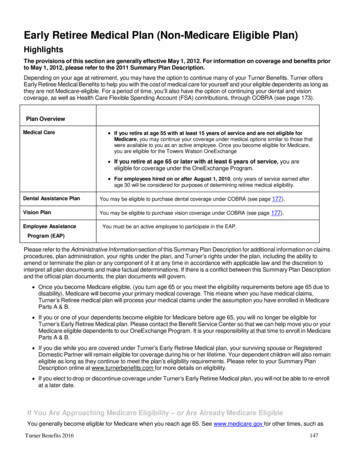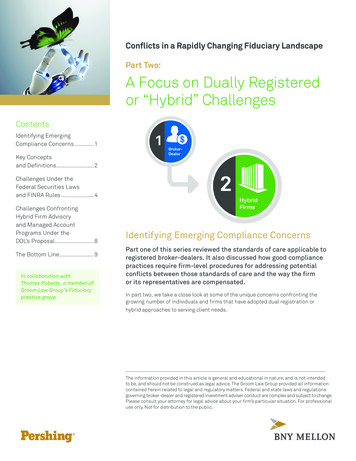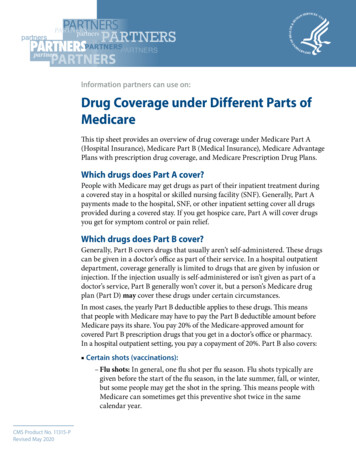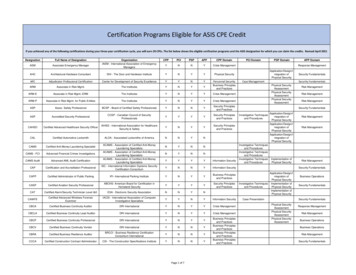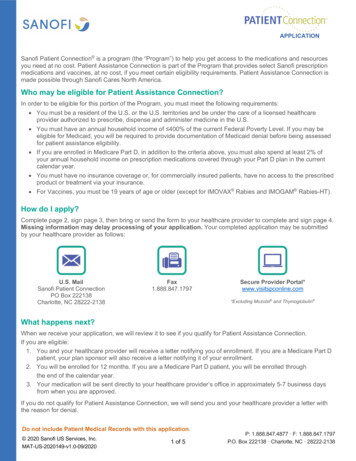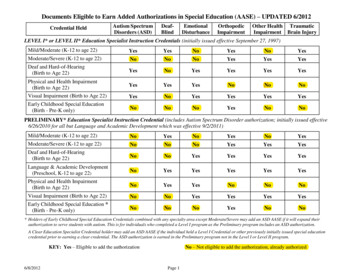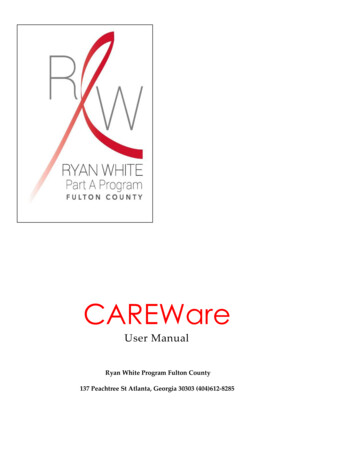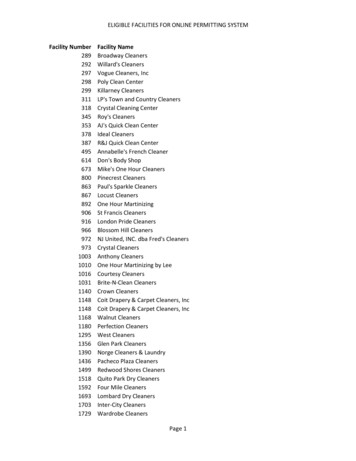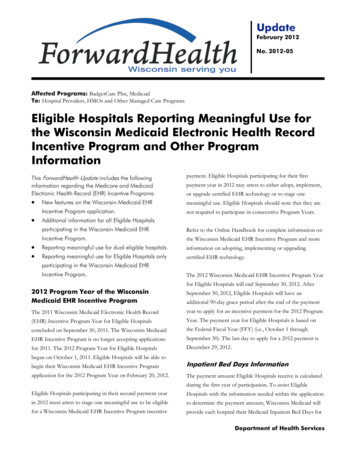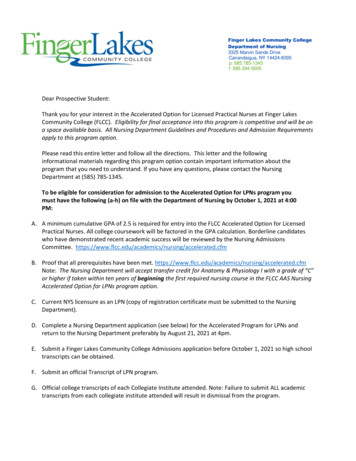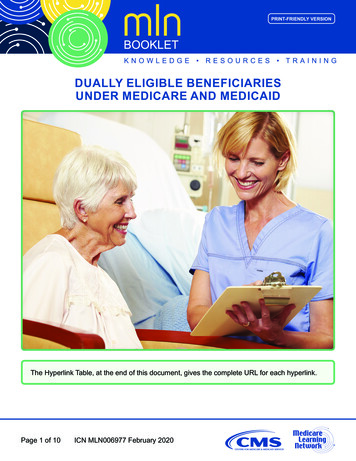
Transcription
PRINT-FRIENDLY VERSIONDUALLY ELIGIBLE BENEFICIARIESUNDER MEDICARE AND MEDICAIDThe Hyperlink Table, at the end of this document, gives the complete URL for each hyperlink.Page 1 of 10ICN MLN006977 February 2020
Dually Eligible Beneficiaries Under Medicare and MedicaidMLN BookletTABLE OF CONTENTSMedicare and Medicaid Programs . 3Dually Eligible Beneficiaries. 4Billing Prohibitions for QMBs . 8Resources . 9Page 2 of 10ICN MLN006977 February 2020
Dually Eligible Beneficiaries Under Medicare and MedicaidMLN BookletLearn about these topics: Medicare and Medicaid Programs Dually eligible beneficiaries Qualified Medicare Beneficiary (QMB) billing prohibitions Additional billing requirements for dually eligible beneficiaries ResourcesMEDICARE AND MEDICAID PROGRAMSMedicare ProgramMedicare is health insurance for people 65 or older, certain people under 65 with disabilities, andpeople of any age with End-Stage Renal Disease.Medicare consists of four parts: Part A – Hospital Insurance (inpatient hospital care,inpatient care in a Skilled Nursing Facility, hospicecare, and some home health services) Part B – Medical Insurance (physician services,outpatient care, durable medical equipment, homehealth services, and many preventive services) Part C – Medicare Advantage (MA) (Medicareapproved private insurance companies cover all Part A and Part B services and may coverprescription drug coverage and other supplemental benefits) Part D – Prescription Drug Benefit (Medicare-approved private companies cover outpatientprescription drug coverage)Medicare beneficiaries get their Medicare coverage one of these ways: Get Part A and Part B services through the Original Medicare Program. To get Part D coverage,they must join a stand-alone Prescription Drug Plan. Get Part A and Part B services from an MA Plan if they reside in its service area. Most MA plansinclude Part D coverage.The Extra Help Program helps pay Medicare monthly premiums, annual deductibles, andcopayments for beneficiaries who have or want Part D coverage and meet certain income andresource limits.Page 3 of 10ICN MLN006977 February 2020
Dually Eligible Beneficiaries Under Medicare and MedicaidMLN BookletMedicaid ProgramMedicaid is a health insurance program funded by Federal and State governments that pays costs forcertain individuals and families with low incomes and, in some cases, limited resources.The Federal government sets the rules, regulations, and policies. Each State operates within thosebroad national guidelines and: Establishes its own eligibility standards Determines the type, amount, duration, and scope of services Sets the service payment rates Administers its own programDUALLY ELIGIBLE BENEFICIARIES“Dually eligible beneficiaries” generally describes beneficiaries enrolled in Medicare and Medicaid.The term includes beneficiaries enrolled in Medicare Part A and/or Part B and getting full Medicaidbenefits and/or assistance with Medicare premiums or cost sharing through the Medicare SavingsProgram (MSP): Qualified Medicare Beneficiary (QMB) Program: Helps pay Part A, Part B, or both Programpremiums, deductibles, coinsurance, and copayments Specified Low-Income Medicare Beneficiary (SLMB) Program: Helps pay Part B premiums Qualifying Individual (QI) Program: Helps pay Part B premiums but is limited to a first-come,first-served basis Qualified Disabled Working Individual (QDWI) Program: Pays Part A premiums for certaindisabled and working beneficiaries under 65 not getting Medicaid and who meet certain incomeand resource limits set by their StateMedicare pays covered dually eligible beneficiaries’ medical services first, because Medicaid isgenerally the payer of last resort. Medicaid may cover medical costs Medicare may not cover or partiallycovers (such as nursing home care, personal care, and home- and community-based services).Coverage for dually eligible beneficiaries varies by State. Some States offer Medicaid throughMedicaid managed care plans, while others provide Fee-For-Service Medicaid coverage. SomeStates contract with health plans that include all Medicare and Medicaid benefits.Federal law defines Medicaid and MSP income and resource standards, but States can effectivelyraise those limits above the Federal floor (except for QDWIs). Annually, the Centers for Medicare &Medicaid Services (CMS) releases eligibility standards for dually eligible beneficiaries.Tables 1 through 7 summarize the eligibility categories for dually eligible beneficiaries, including eachcategory’s benefits and basic qualifications.Page 4 of 10ICN MLN006977 February 2020
Dually Eligible Beneficiaries Under Medicare and MedicaidMLN BookletTable 1. Full Medicaid (only)Benefits &QualificationsDescriptionBenefits Full Medicaid coverage refers to the package of services, beyond coveragefor Medicare premiums and cost-sharing that certain individuals are entitledwhen they qualify under eligibility categories covered under a State’s MedicaidProgram. Some of these coverage groups are ones that States must cover (forexample, Supplemental Security Income [SSI] beneficiaries), and some areones that States have the option to cover (for example, the “special incomelevel” institutionalized group for individuals or home- and community-basedwaiver participants and “medically needy” individuals). Individuals who get Medicaid only are enrolled in Medicare Part A and/or Band qualify for full Medicaid benefits but not for the Medicare Savings Programcategories. However, the State may pay for their Part B premiums. Beneficiaries pay no more than the amount allowed under the State’s MedicaidProgram for services furnished by Medicare providers.Qualifications States determine income and resources criteria. States can require Part A or B enrollment if they pay the premiums for theseParts on the individual’s behalf. Individuals must demonstrate they need a certain level of care or meetState-specific medical criteria to qualify for certain categories.Table 2. QMB Only Without Other MedicaidBenefits &QualificationsDescriptionBenefits Medicaid pays Part A (if any) and Part B premiums. Medicaid pays Medicare deductibles, coinsurance, and copayments forservices furnished by Medicare providers for Medicare-covered items andservices (even if the Medicaid State Plan payment does not fully pay thesecharges, the QMB is not liable for them).Qualifications Income can be up to 100% of the Federal Poverty Level (FPL). Resources cannot be more than 3 times the SSI resource limit, increasedannually by the Consumer Price Index (CPI). To qualify for QMB, the beneficiary must be enrolled in Part A (or if uninsuredfor Part A, have filed for premium Part A on a conditional basis). For moreinformation, refer to the SSA Program Operations Manual System § HI 00801.140.Page 5 of 10ICN MLN006977 February 2020
Dually Eligible Beneficiaries Under Medicare and MedicaidMLN BookletTable 3. QMB PlusBenefits &QualificationsDescriptionBenefits Medicaid pays Part A (if any) and Part B premiums. Medicaid pays Medicare deductibles, coinsurance, and copayments forservices furnished by Medicare providers for Medicare-covered items andservices (even if the Medicaid State Plan payment does not fully pay thesecharges, the QMB is not liable for them). Get “full Medicaid” coverage in addition to coverage for Medicare premiumsand cost-sharing (see Table 1 for a definition of full Medicaid coverage).Qualifications Meet the QMB-related eligibility requirements described in Table 2 and theeligibility requirements for full Medicaid in Table 1.Table 4. SLMB Only Without Other MedicaidBenefits &QualificationsDescriptionBenefits Medicaid pays Part B premiums.Qualifications Income between 100% and 120% of the FPL. Resources cannot be more than 3 times the SSI resource limit, increasedannually based on the CPI. Individuals must be enrolled in Part A.Table 5. SLMB PlusBenefits &QualificationsDescriptionBenefits Medicaid pays Part B premiums. Get “full Medicaid” coverage in addition to coverage for Medicare Part Bpremiums (see Table 1 for a definition of full Medicaid coverage).Qualifications Meet the SLMB-related eligibility requirements described in Table 4 and theeligibility requirements for full Medicaid in Table 1.Page 6 of 10ICN MLN006977 February 2020
Dually Eligible Beneficiaries Under Medicare and MedicaidMLN BookletTable 6. QIBenefits &QualificationsBenefitsQualificationsDescription Medicaid pays Part B premiums. Benefits are limited to first-come, first-served. Income between 120% and 135% of the FPL. Resources cannot be more than 3 times the SSI resource limit, increasedannually by the CPI. Individuals must be enrolled in Part A. QI beneficiaries are ineligible for any other Medicaid coverage.Table 7. QDWIBenefits &QualificationsBenefitsDescription Medicaid pays Part A premiums. Income up to 200% of the FPL. Resources up to 2 times the SSI resource limit.QualificationsPage 7 of 10 Individuals under 65 with a qualifying disability who lost premium-free Part Acoverage after returning to work and now must enroll in and purchase Part Acoverage. QDWI beneficiaries are ineligible for any other Medicaid coverage.ICN MLN006977 February 2020
Dually Eligible Beneficiaries Under Medicare and MedicaidMLN BookletBILLING PROHIBITIONS FOR QMBS All original Medicare and Medicare Advantage providers and suppliers – not only those that acceptMedicaid – cannot charge QMBs for Medicare cost sharing for covered Parts A and B services.(Note: QMBs cannot elect to pay Medicare deductibles, coinsurance, and copays, but may havea small Medicaid copay.) Medicare Remittance Advice notices clearly indicate if a beneficiary is a QMB and show thebeneficiary’s deductible, copayment, and coinsurance cost-sharing is zero. If a provider bills a QMB for Medicare cost-sharing, or turns a bill over to collections, the providermust recall it. If the provider collects any cost-sharing money from a QMB, the provider mustrefund it. A provider may be subject to sanctions if it bills a QMB for amounts above the total of all Medicareand Medicaid payments (even when Medicaid does not fully pay the Medicare cost-sharing).For more information, see the Prohibition Billing Dually Eligible Individuals Enrolled in the QualifiedMedicare Beneficiary (QMB) Program MLN Matters article.Additional Billing Requirements for Dually Eligible Beneficiaries All Medicare providers must accept assignment for Part B-covered services furnished to duallyeligible beneficiaries. Assignment means the Medicare Physician Fee Schedule amount ispayment in full. Special instructions apply when a provider issues an Advance Beneficiary Notice (ABN) to a duallyeligible beneficiary, based on the expectation that Medicare will deny the item or service becauseit is not medically reasonable and necessary or constitutes custodial care. The provider cannot bill the dually eligible beneficiary when the ABN is furnished. Once the claim is adjudicated by both Medicare and Medicaid, providers may only charge thepatient in the following circumstances: If the beneficiary has QMB coverage without full Medicaid coverage, the ABN could allow theprovider to shift financial liability to the beneficiary per Medicare policy. If the beneficiary has full Medicaid coverage and Medicaid denies the claim (or will not paybecause the provider does not participate in Medicaid), the ABN could allow the provider toshift financial liability to the beneficiary per Medicare policy, subject to any State laws that limitbeneficiary liability.For more information, see the ABN Form and Instructions.Page 8 of 10ICN MLN006977 February 2020
Dually Eligible Beneficiaries Under Medicare and MedicaidMLN BookletRESOURCESTable 8. Dually Eligible Beneficiary ResourcesResourcesWebsiteDually Eligible Individuals – olleeCategories.pdfExtra Help icare Administrative Contractor ContactsGo.CMS.gov/MAC-website-listMedicare Advantage and Other Medicare HealthPlans – General nsGenInfoMedicare and Medicaid ICN909330Medicare Claims Processing Manual, Chapter 1—General Billing Requirements, Section 200 –Qualified Medicare Beneficiary (QMB) ProgramMedicare General Information, Eligibility, andEntitlement: Chapter 2—Hospital Insurance andSupplementary Medical InsuranceMedicare Information for ance/Manuals/Downloads/clm104c01.pdfMedicare Managed Care dicare-Medicaid Coordination rdination-OfficeMedicare Prescription Drug Benefit ge 9 of 10ICN MLN006977 February als/Downloads/ge101c02.pdfMedicare.gov
Dually Eligible Beneficiaries Under Medicare and MedicaidMLN BookletTable 8. Dually Eligible Beneficiary Resources (cont.)ResourcesWebsiteMedicare Savings aying-costs/medicare-savings-programsMedicare Summary Notice (MSN) Changes toAssist Beneficiaries Enrolled in the QualifiedMedicare Beneficiary (QMB) 230.pdfPrescription Drug Coverage—General Information iptionDrugCovGenInQualified Medicare Beneficiary (QMB) ordination-Office/QMBSocial Security Administration’s Role in Medicare Secure.SSA.gov/poms.nsf/lnx/0600815024Savings Programs (MSP) ApplicationsTable 9. Hyperlink TableEmbedded HyperlinkComplete URLABN Form and eneral-Information/BNI/ABNDeductibles, Coinsurance, and ostsDually Eligible gibility/index.htmlExtra Help ogramsProhibition on Billing Dually Eligible IndividualsEnrolled in the Qualified Medicare Beneficiary(QMB) wnloads/SE1128.pdfSSA Program Operations Manual System § lnx/0600801140Medicare Learning Network Content Disclaimer, Product Disclaimer, and Department of Health & Human Services DisclosureThe Medicare Learning Network , MLN Connects , and MLN Matters are registered trademarks of the U.S. Departmentof Health & Human Services (HHS).Page 10 of 10ICN MLN006977 February 2020
All original Medicare and Medicare Advantage providers and suppliers – not only those that accept Medicaid – cannot charge QMBs for Medicare cost sharing for covered Parts A and B services. (Note: QMBs cannot elect to pay Medicare deductibles, coins

